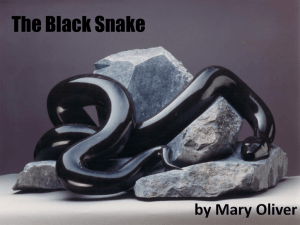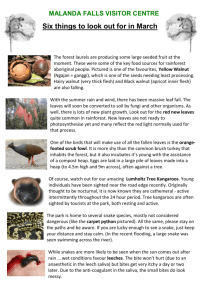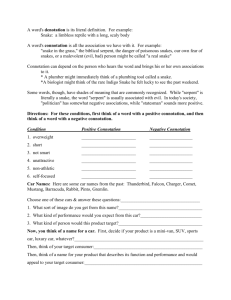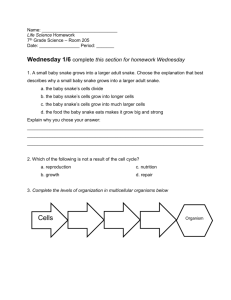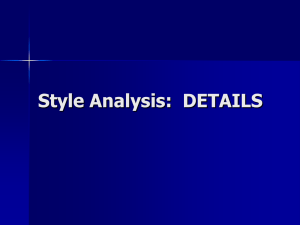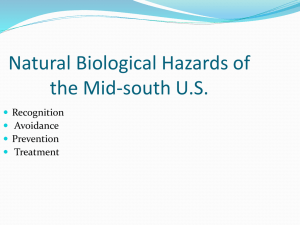A Narrow Fellow in the Grass
advertisement
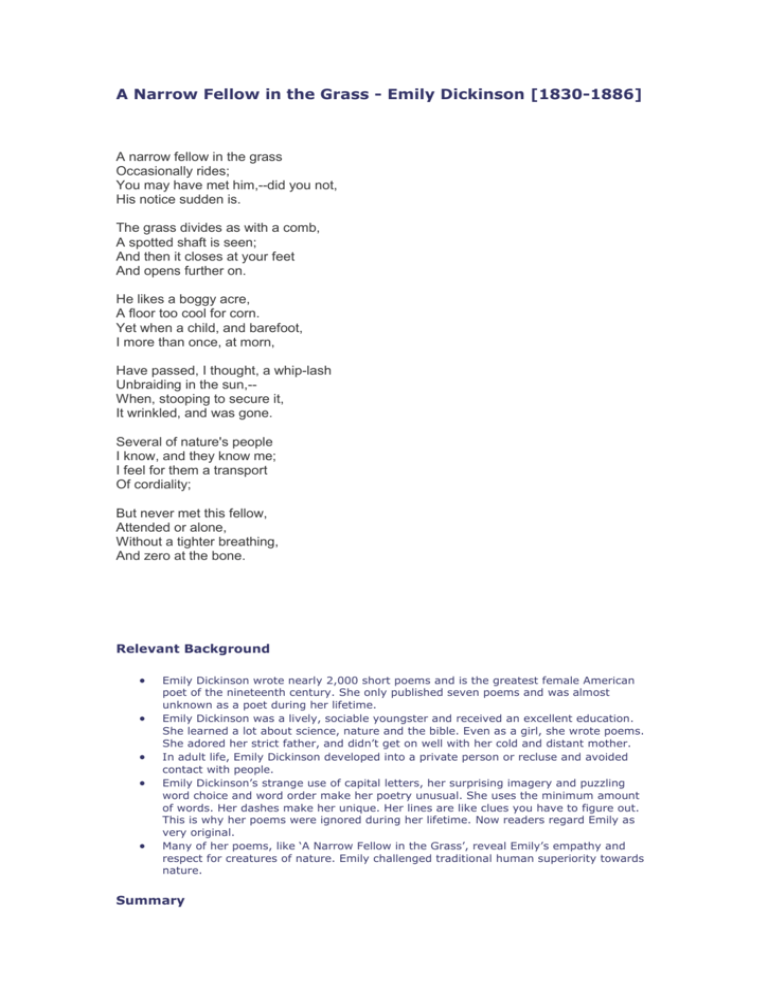
A Narrow Fellow in the Grass - Emily Dickinson [1830-1886] A narrow fellow in the grass Occasionally rides; You may have met him,--did you not, His notice sudden is. The grass divides as with a comb, A spotted shaft is seen; And then it closes at your feet And opens further on. He likes a boggy acre, A floor too cool for corn. Yet when a child, and barefoot, I more than once, at morn, Have passed, I thought, a whip-lash Unbraiding in the sun,-When, stooping to secure it, It wrinkled, and was gone. Several of nature's people I know, and they know me; I feel for them a transport Of cordiality; But never met this fellow, Attended or alone, Without a tighter breathing, And zero at the bone. Relevant Background Emily Dickinson wrote nearly 2,000 short poems and is the greatest female American poet of the nineteenth century. She only published seven poems and was almost unknown as a poet during her lifetime. Emily Dickinson was a lively, sociable youngster and received an excellent education. She learned a lot about science, nature and the bible. Even as a girl, she wrote poems. She adored her strict father, and didn’t get on well with her cold and distant mother. In adult life, Emily Dickinson developed into a private person or recluse and avoided contact with people. Emily Dickinson’s strange use of capital letters, her surprising imagery and puzzling word choice and word order make her poetry unusual. She uses the minimum amount of words. Her dashes make her unique. Her lines are like clues you have to figure out. This is why her poems were ignored during her lifetime. Now readers regard Emily as very original. Many of her poems, like ‘A Narrow Fellow in the Grass’, reveal Emily’s empathy and respect for creatures of nature. Emily challenged traditional human superiority towards nature. Summary The reader has to read and then solve the clues in this poem to realise that the subject of the poem is a snake. This poem avoids the customary attitude that the snake is evil, or is a symbol of evil. Dickinson treats the snake as a fellow creature. In the first stanza, the poet compares the snake’s movement in the grass to human movement. When she wrote this poem, it was common for people to ride on horseback. According to Dickinson, the snake rides along in the grass. This is different than the usual idea that the snake slithers or crawls. The poet claims that a first meeting with a snake is startling or unexpected. In the second stanza, the poet compares the way the snake divides the grass to a spotted comb splitting the meadow. The snake’s movements both close and open the split in the meadow. In the third stanza, the poet explains the cool, moist location that the snake enjoys. Then the poet reveals that in her childhood, she was more like a boy due to her sense of adventure and interest in exciting activities. She liked close contact with nature, ‘barefoot’. She was spellbound by snakes and bravely bent to pick them up when she saw them unwinding in the grass. The snake was both as dangerous and as quick as the flick of a whip. Yet, young Dickinson was fascinated. The snake was hard to get hold of because it vanished into the grass with one twist or wrinkle. In the fourth stanza, Dickinson reveals how she is familiar with various creatures that she regards as equal to her. She feels an emotion, ‘transport’, of friendliness, ‘cordiality’, for these creatures. In the fifth stanza, Dickinson admits that every time she came across this particular snake she became tense with fear. She came across this type of snake, with the spotted shaft, frequently, either alone or in company. Her instinct always caused her to be afraid. Her breathing became tight and she made an ‘o’ shape, ‘zero’, with her mouth or felt a chill down her spine. Themes Respect for nature. Dickinson regards animals as ‘Nature’s People’. Snakes are independent, like all creatures of nature, and deserve our respect. A snake is a ‘fellow’ that gives ‘notice’ of his presence. The message is don’t take snakes for granted. Animals enjoy their own special environment. Snakes like a certain environment or location, a ‘Boggy acre’ with grass. Nature inspires fear Despite Dickinson’s fondness for the snake, she felt its strangeness. She experienced fear whenever she met a snake in the meadow: ‘a tighter breathing’. The snake is elusive While it is possible to see a snake, it is too quick for human hands to catch it. As Dickinson bent to grab it, the snake ‘wrinkled and was gone’. The poet avoids labels and sees creatures as they are. The word snake is not used. From description, we work out that the subject of the poem is a snake. She uses words like ‘narrow’, ‘spotted shaft’ and ‘Whip lash’ to indicate the appearance of the creature. We draw our own conclusions. Childhood Dickinson recalls her childhood sense of adventure. She remembers how nature intrigued her. Growing up in a century that had fixed images of what boys and girls did [stereotyping], she was boyish rather than typically feminine in her interests. Dickinson was curious, brave and natural in her feelings. Style Metaphor: The poet compares the motion of a snake to a rider. She compares the quick movement of the snake’s tail to a ‘whip lash’. Animals are compared to ‘Nature’s people’. Simile: Dickinson directly compares the body of the snake to a comb, splitting the meadow. Contrast: Dickinson contrasts two different emotional responses to the snake: joy and fear. ‘Cordiality’ contrasts with ‘tighter breathing’. Punctuation: Dashes allow the reader time to think and feel, like after the second line. The reader tries hard to solve the puzzle of the clues. The dashes create the impression of a hesitant voice, as if the poet is genuinely trying to remember bits and pieces of childhood. The dashes help to make the poet’s voice in the poem seem remote or distant, as if she is speaking from another dimension. Simple diction: Even though the word order is strange, most of the words are simple. They consist mainly of one or sometimes two syllables. The first stanza illustrates this. The simple diction or word choice shows the down-to-earth nature of the poet’s approach to nature. The strange word order of the fourth line imitates the shock she felt on suddenly observing the snake. Longer words like ‘cordiality’ cause the reader to pause and dwell on their meanings. Tone: There are tones of mystery, respect, fear, joy, and amazement. The tone or attitude of the poet varies from warm to cold. Atmosphere: There are some frightening images of the threatening nature of the snake like ‘sudden’ and ‘whiplash’. It brings on a ‘tighter breathing. Behind her amazement at the snake lies the poet’s fear. Alliteration: Phrases like ‘spotted shaft’ and ‘a Boy and Barefoot’ create music in the poem and strengthen the impact of the images. The alliteration shows how natural a child Dickinson was in her boy-like antics. Sibilance [repetition of ‘s’ sound]: The four repeated ‘s’ sounds in the line ‘His notice sudden is’ convey the presence and sound of a snake very well.
